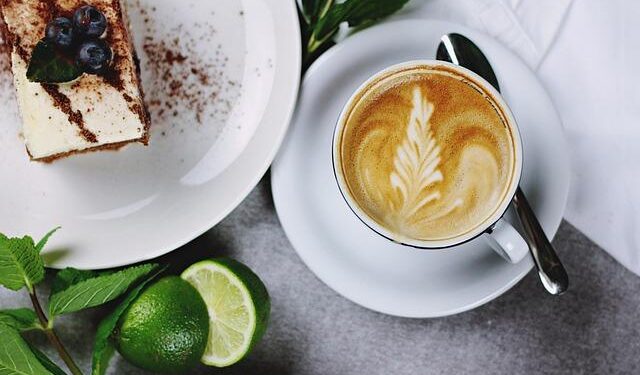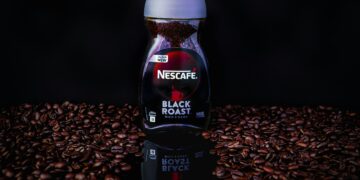Table of Contents
Introduction: The Heartbreak of the Home-Brewed Iced Latte
As a culinary R&D specialist, my professional life is a world of controlled variables, precise measurements, and the relentless pursuit of flavor.
But at home, my personal quest for the perfect iced coffee was a series of heartbreaking failures.
I could envision it so clearly: a vibrant, complex, soul-satisfying glass of iced coffee, layered with authentic flavor.
Yet, the reality was always a pale, disappointing imitation.
My breaking point came one sunny afternoon when I attempted to craft a sophisticated lavender-honey latte.
I had seen similar drinks on cafe menus and found a popular recipe online.
I followed it to the letter.
The result was a disaster.
The delicate floral note I imagined was a harsh, soapy perfume, an artifact of cheap extract.
The honey’s sweetness was cloying and one-dimensional, completely bulldozing the subtle notes of the coffee itself.
The entire concoction was thin, watery, and ultimately, undrinkable.
It was a watery grave for good coffee beans.1
That failure forced me to ask a fundamental question: Why do our homemade creations, even when we diligently follow recipes, so often fall flat? Why do they lack the depth, balance, and soul of a professionally made drink? The answer, I would discover, had nothing to do with finding a better recipe.
It required a completely new way of thinking.
Part 1: The Flavor Trap: Deconstructing Why Our Iced Coffee Fails
My investigation began by deconstructing the common methods and “hacks” that form the foundation of most homemade iced coffee.
I realized that the problem isn’t a lack of effort; it’s that we’re using a flawed toolkit.
We are trapped by two core problems: dilution and deception.
The Dilution Dilemma: A Watery Grave for Flavor
The undisputed number one enemy of great iced coffee is dilution.1
This isn’t merely about the drink getting watered down; it’s a catastrophic event that strips away flavor intensity, body, and aroma, leaving you with a weak, often lukewarm beverage.2
The primary culprit is the cardinal sin of home brewing: pouring freshly brewed hot coffee directly over i.e.1
The extreme temperature difference causes the ice to melt almost instantly, creating a beverage that is a shadow of its potential.
To combat this, we turn to a few common but ultimately incomplete fixes.
First, we try brewing the coffee stronger.
This seems logical; a more concentrated base should stand up to dilution.1
While brewing with a higher coffee-to-water ratio is a necessary step, it’s not a complete solution.
If the underlying flavor architecture is missing, you often just end up with a more bitter or acidic base, not a more complex or enjoyable one.
Next, we turn to cold brew, celebrated for its smooth, low-acid profile.5
Cold brew provides a superior canvas, but it is still just a canvas.
It mitigates the acidity problem but doesn’t solve the core challenge of how to build rich, layered flavor on top of that base.
Furthermore, it introduces its own set of potential mistakes, such as using the wrong grind size (too fine leads to bitterness) or improper steeping times (too short is weak, too long can be harsh).7
Finally, there’s the clever trick of using coffee ice cubes.4
This is an excellent defensive maneuver.
It smartly prevents the drink from getting
worse as the ice melts.
But it doesn’t actively make the drink better.
It stops the bleeding but doesn’t heal the wound.
It fails to add the new layers of aromatic, complex flavor that separate a passable drink from a phenomenal one.
The Syrup Deception: The Twin Illusions of Sweetness
With our base coffee protected from the worst of dilution, we face the second trap: flavoring.
Here, we’re presented with a false choice between a homemade void and a commercial compromise.
The standard homemade simple syrup is just that: simple.
It’s a 1:1 mixture of sugar and water, boiled until dissolved.3
It adds sweetness, but it’s a flat, one-dimensional sweetness.
It contributes no aromatic complexity, no texture, and no bright, acidic notes.
When we try to flavor it with common extracts like vanilla or almond, the result can often taste artificial and simplistic, a single, loud note in an otherwise silent room.3
Frustrated, we might turn to store-bought flavored syrups.
This is where we encounter the “dark side” of flavored coffee.11
Many of these products are not designed to complement high-quality coffee, but to completely obscure the taste of lower-quality beans.11
They often achieve this using flavor compounds mixed with a chemical solvent like propylene glycol—a substance also used in pharmaceuticals and airplane de-icing—to bind the artificial flavor to the beans or syrup.11
These syrups are engineered to be intensely aromatic, engaging the sense of smell more than taste, which explains the overpowering, lingering, and artificial character of my failed lavender latte.11
This is the trap: our homemade syrups are boring, and the commercial ones often taste fake.
We are stuck between the incomplete and the inauthentic.
This realization was my call to adventure.
There had to be a third Way.
Part 2: The Mixologist’s Epiphany: A New Architecture for Flavor
The turning point came not in my kitchen, but while watching a master bartender at a high-end cocktail bar.
I watched, fascinated, as they built a drink.
They weren’t just pouring a spirit and a mixer into a glass.
They were meticulously constructing a flavor experience.
They used one component for aromatic brightness, another for herbal depth, and a third for a rich, textured body.
They weren’t adding a flavor; they were building flavor architecture.
That was the epiphany.
The fundamental flaw in my approach to iced coffee was conceptual.
I was thinking like a home cook, trying to add a single flavoring element.
The bartender was thinking like an architect, using multiple, specialized components to build a balanced, multi-layered structure.
The solution to my coffee problem wasn’t in the coffee aisle; it was behind the bar.
I needed to learn the techniques of mixology.
I identified three foundational pillars of cocktail construction that could be adapted to revolutionize iced coffee, each one solving a specific problem that simple syrup alone cannot.
Pillar I – Infusion (Capturing Soul & Body)
- What it Solves: The problem of flat, one-dimensional flavor and the harsh, artificial taste of extracts.
- The Technique: Infusion is the art of gently extracting flavor and aromatic compounds from ingredients like herbs, spices, and fruits into a liquid solvent.12 For our purposes, the most valuable technique is
maceration, which involves steeping ingredients in a liquid (in this case, our syrup base) at room temperature.12 This slow, gentle process captures the true, nuanced essence of delicate ingredients without the high heat that can cook them, alter their flavor, or destroy their soul. - Application for Coffee: This is the perfect solution for capturing the authentic character of whole spices like cinnamon, star anise, and cardamom, or fresh herbs like mint, basil, and rosemary—all flavors gaining momentum in the coffee world.13 Most importantly, it’s how you capture the true essence of florals like culinary-grade lavender, rose, or chamomile, avoiding the soapy disaster of my past.15
Pillar II – Oleo Saccharum (Capturing Aroma & Top Notes)
- What it Solves: The complete lack of vibrant, fresh aroma that plagues most homemade drinks.
- The Technique: This is a bartender’s secret weapon, a piece of liquid magic with a history stretching back centuries.16 Oleo Saccharum, Latin for “oil-sugar,” is a syrup made without water. Instead, it uses the hygroscopic nature of sugar to physically pull the intensely fragrant essential oils directly from the peels of citrus fruits.16 The process involves tossing fresh peels with sugar, muddling them gently to break down the oil sacs, and allowing the mixture to rest as the sugar becomes a rich, glossy, and powerfully aromatic syrup.18
- Application for Coffee: This technique is the key to unlocking the bright, zesty, and complex top notes that make a drink feel alive. It’s vastly superior to using citrus juice, which primarily adds acidity but little of the peel’s aromatic magic. This method directly addresses the growing trend of fruit and citrus-infused coffees, providing a way to capture that flavor authentically.8
Pillar III – Shrubs (Capturing Brightness & Complexity)
- What it Solves: The common problem of iced coffee being either bland or cloyingly sweet, lacking any dynamic contrast.
- The Technique: Shrubs, also known as drinking vinegars, are tangy-sweet syrups made from fruit, sugar, and vinegar.19 The vinegar acts as a secret weapon, adding a layer of acidic brightness that cuts through the richness of coffee and milk, balancing the sweetness and making the entire beverage more refreshing and complex.20 There are two main methods: a “hot process” where ingredients are simmered, and a “cold process” where fruit and sugar macerate before vinegar is added, preserving the fresh fruit character.21
- Application for Coffee: Shrubs are a game-changer for fruit-flavored iced coffees. They are especially brilliant for capturing the essence of berries (strawberry, raspberry, blackberry) and stone fruits (peach, plum, cherry), creating a perfect sweet-tart harmony that elevates the entire drink.22
Part 3: The Flavor Architect’s Blueprint: Your New Iced Coffee Toolkit
Armed with this new architectural framework, it’s time to build.
This is the hands-on workshop, providing the core recipes for our three pillars and then showing how to assemble them into finished masterpieces that are worlds away from the watery, artificial drinks of the past.
The Foundation: Core Architectural Recipes
These are your new building blocks.
Master them, and you can create nearly any flavor profile you can imagine.
Recipe 1: Spiced Infused Syrup (Cinnamon-Clove-Star Anise)
This syrup captures the warm, complex soul of whole spices, perfect for adding depth and a comforting aroma.
- Ingredients: 1 cup water, 1 cup granulated sugar, 2 cinnamon sticks, 4 whole cloves, 1 star anise.9
- Instructions:
- Combine water and sugar in a saucepan over medium heat. Stir until the sugar is completely dissolved. Do not boil.
- Remove from heat and pour the warm syrup into a clean glass jar.
- Add the cinnamon sticks, cloves, and star anise to the warm syrup.
- Seal the jar and let it steep at room temperature for at least 12 hours, or up to 24 hours for a more intense flavor.
- Strain out the whole spices. The syrup can be stored in the refrigerator for up to 2 weeks.24
Recipe 2: Aromatic Oleo Saccharum (Orange & Rosemary)
This technique creates a powerfully aromatic syrup with bright citrus top notes and an herbal backbone.
- Ingredients: Peels from 2 large, unwaxed oranges (avoiding the white pith), 2/3 cup granulated sugar, 2 fresh rosemary sprigs.14
- Instructions:
- Place the orange peels and sugar in a bowl or a zip-top bag.
- Using a muddler or the back of a wooden spoon, gently press and bruise the peels into the sugar to help release their oils.
- Add the rosemary sprigs. Seal the bag or cover the bowl and let it sit at room temperature for 4 to 24 hours.
- You will see a liquid pool of intensely fragrant oil-syrup form as the sugar dissolves.
- Once most of the sugar has liquified, strain the syrup from the peels and rosemary. Store in a sealed jar in the refrigerator for up to one week.18
Recipe 3: Bright Fruit Shrub (Raspberry & Thyme)
This cold-process shrub preserves the fresh, vibrant flavor of berries, balanced by a tangy brightness and a hint of herbs.
- Ingredients: 1 cup fresh raspberries, 1 cup granulated sugar, 2-3 sprigs of fresh thyme, 1 cup apple cider vinegar.21
- Instructions:
- In a clean jar, combine the raspberries, sugar, and thyme. Muddle gently to crush the berries.
- Seal the jar and let it sit in the refrigerator for 24-48 hours. The sugar will draw the juice from the berries, creating a rich fruit syrup.
- After macerating, strain the syrup through a fine-mesh sieve, pressing on the solids to extract all the liquid. Discard the solids.
- Combine the fruit syrup with the apple cider vinegar. Whisk well.
- Store in a sealed jar in the refrigerator. The flavor will mellow and improve after a few days and will keep for several months.19
The Assembly: Signature Build Recipes
Now, we assemble.
The true magic happens when you layer these components, using one for body and another for aroma, or combining them to create contrast and complexity.
This is the replicable workflow I discovered, turning failure into success.
Recipe 4: The “Gilded Hour” Spiced Orange Cold Brew
This drink demonstrates layering, using an infused syrup for its deep, spicy body and an oleo saccharum for its bright, aromatic finish.
It pairs beautifully with the low-acid, chocolatey notes of a good cold brew.25
- Build:
- Fill a tall glass with ice.
- Add 1 oz (2 tablespoons) of Spiced Infused Syrup.
- Add 1/2 oz (1 tablespoon) of Orange & Rosemary Oleo Saccharum.
- Pour in 6 oz of cold brew concentrate.
- Top with 2 oz of cold water or milk of your choice. Stir gently and garnish with an orange twist.
Recipe 5: The “Summer Orchard” Peach & Basil Iced Latte
This build shows how to use a shrub for brightness and an infusion for a fresh counterpoint, creating a drink that is both creamy and refreshingly complex.
- Build:
- First, create a Peach Shrub (using the same method as the Raspberry Shrub) and a Basil Infused Syrup (using the same method as the Spiced Infusion).
- In a shaker, combine 1 oz of Peach Shrub, 1/2 oz of Basil Infused Syrup, and 2 shots of chilled espresso.
- Add ice and shake until well-chilled.
- Strain into an ice-filled glass and top with 4-5 oz of your favorite milk.
Recipe 6: The “Pistachio Rose Dream” (A Redemption Story)
Here, I redeem my original failure.
By using a gentle infusion for the floral note and a rich, nutty base, I can finally create the sophisticated latte I imagined.
The pistachio trend, driven by social media, provides the perfect nutty, indulgent base.26
- Build:
- Create a Rose Infused Syrup by steeping 2 tablespoons of culinary-grade dried rose petals in 1 cup of warm simple syrup for 8 hours, then straining.15
- Create a Pistachio Cream Syrup by whisking 2 tablespoons of high-quality pistachio paste into 6 oz of milk until smooth.26
- In a tall glass, combine 1/2 oz of the Rose Infused Syrup with the Pistachio Cream Milk.
- Add ice.
- Gently pour 2 shots of chilled espresso over the top. Garnish with crushed pistachios. The result is balanced, aromatic, and authentically delicious.
Part 4: A Global Atlas of Flavor: Charting Your Next Creation
This architectural approach doesn’t just fix our past failures; it unlocks the future.
The emerging global trends in coffee—toward complex botanicals, authentic fruit notes, and warm spices—are nearly impossible to achieve with basic syrups and extracts.
But they are perfectly suited for the nuanced techniques of infusion, oleo saccharum, and shrubs.
This framework is the key to creating cutting-edge, market-relevant flavors right in your own kitchen.
Regional Flavor Profiles & Analysis
The world of coffee flavor is diverse and dynamic.
Understanding regional preferences provides a roadmap for your own creations.
- North America: The market is defined by a love for comforting, indulgent “brown” flavors like caramel, vanilla, and hazelnut.13 There’s a strong and growing trend toward dessert-inspired profiles like crème brûlée and bakery flavors (cake, donut).31 Alongside this indulgence is a surge in spice-forward notes like cinnamon and nutmeg and a significant push into functional coffee with additives like adaptogens and CBD.5
- United Kingdom: The UK presents a fascinating blend of deep-rooted tradition and hyper-modern trends. Instant coffee remains a household staple, yet the market is simultaneously swept by “Matcha Mania” and a craze for pistachio-flavored everything.29 Plant-based milks are becoming the default standard, and seasonal flavors are highly defined: warming spices like gingerbread and peppermint in winter, and lighter floral and citrus notes like lavender in the spring.35
- Asia-Pacific & Australia/New Zealand (ANZ): The broader APAC region shows a strong interest in locally inspired flavors like coconut, red bean, and ube.13 In Australia specifically, the Ready-to-Drink (RTD) coffee market is a major driver of innovation. The two dominant trends are the integration of functional ingredients (protein, MCT oil, adaptogens) and a massive shift toward plant-based and dairy-free options, with oat milk leading the charge.37
This global data isn’t just trivia; it’s a creative blueprint.
The table below connects these global trends directly to the architectural techniques you’ve just learned, transforming passive knowledge into an active guide for your next creation.
| Region | Dominant Flavor Profile | Key Trending Flavors | Emerging Concepts | Recommended Architectural Technique |
| North America | Comfort & Indulgence | Caramel, Hazelnut, French Vanilla, Mocha, Cinnamon 13 | Dessert-inspired (Crème brûlée, cake), Spice-forward (nutmeg, cardamom), Functional (adaptogens) 13 | Infusion for whole spices & botanicals. Pastry-style syrups for rich, nutty, and dessert flavors. Oleo Saccharum for bright citrus notes in seasonal drinks. |
| UK / Europe | Modern & Botanical | Pistachio, Matcha, Lavender, Seasonal Spices (Gingerbread, Peppermint) 29 | Plant-based as standard, Premiumization (specialty beans), The “Long Black” coffee style 29 | Infusion for delicate florals (lavender, rose) and herbs. Rich syrups/creams for nutty flavors like pistachio. Shrubs for balancing fruit-forward spring/summer drinks. |
| Asia-Pacific / ANZ | Functional & Regional | Coconut, Ube, Tropical Fruits (Mango, Lychee), Plant-based milks (Oat) 13 | RTD functional beverages (protein, collagen), Dairy-free as a primary driver, Single-origin focus 26 | Shrubs using regional vinegars (rice, coconut) for authentic tang. Infusion for capturing subtle tea and botanical notes. Oleo Saccharum for tropical fruit peel aromatics. |
Conclusion: Your Invitation to the Architect’s Table
My journey began with a single, spectacular failure—a watery, soapy lavender latte that nearly made me give up on homemade iced coffee altogether.
It ended with a complete shift in perspective.
The problem was never the recipe; it was the entire philosophy.
By looking outside the world of coffee and into the architectural thinking of mixology, I found the keys.
The core message is this: Stop thinking about adding flavor.
Start thinking about building it.
The three pillars—Infusion for soul, Oleo Saccharum for aroma, and Shrubs for brightness—are more than just techniques.
They are a new language for flavor.
They give you the control to capture the authentic essence of an ingredient, to balance sweetness with acidity, and to layer complexity into every glass.
They transform you from a passive recipe-follower into an active Flavor Architect.
I invite you to join me at the architect’s table.
Pick one technique—perhaps an infusion with your favorite spice.
Start small.
Experiment.
Taste the difference between a flat vanilla extract and a syrup infused with a real vanilla bean.
Experience the vibrant aroma of an oleo saccharum that you coaxed from a simple orange peel.
Discover the delightful tang a berry shrub brings to your latte.
This is where the real joy Is. The most delicious coffee you will ever have is not one you buy, but one you understand, design, and create yourself.
Works cited
- Mistakes You’re Making With Iced Coffee – Tasting Table, accessed August 4, 2025, https://www.tastingtable.com/1654937/mistakes-iced-coffee/
- Baristas Share People’s Biggest Mistakes Making Iced Coffee – CoffeeTalk, accessed August 4, 2025, https://coffeetalk.com/daily-dose/for-roasters-retailers/06-2024/103383/
- How to Make the Best Sweet Iced Coffee (Easy Recipe) – Home & Plate, accessed August 4, 2025, https://www.homeandplate.com/blog/how-to-make-the-best-sweet-iced-coffee-easy-recipe/
- 6 Simple Ways To Prevent Watery Homemade Iced Coffee, accessed August 4, 2025, https://www.slurrp.com/article/6-simple-ways-to-prevent-watery-homemade-iced-coffee-1729329262698
- Top Coffee Trends to Look Out for in 2024, accessed August 4, 2025, https://hotshotsleeves.com/coffee/newest-coffee-trends/
- Our Picks for The Top Iced Coffee Drinks of 2024 – 7-Eleven, accessed August 4, 2025, https://www.7-eleven.com/blog/food-and-drink/our-picks-for-the-top-iced-coffee-drinks-of-2024
- Six Common Mistakes When Making Cold Brew Coffee, accessed August 4, 2025, https://groundsandhoundscoffee.com/blogs/recent-posts/six-common-mistakes-when-making-cold-brew-coffee
- 10 Ways to Upgrade Your Iced Coffee – Kitchen Treaty, accessed August 4, 2025, https://www.kitchentreaty.com/10-ways-to-upgrade-your-iced-coffee/
- Sugar Syrup for Cakes – Recipe + Flavours – Sweetness and Bite, accessed August 4, 2025, https://sweetnessandbite.com/ultimate-guide-to-sugar-syrup-for-cakes/
- How to Make Iced Coffee Recipe – Love and Lemons, accessed August 4, 2025, https://www.loveandlemons.com/iced-coffee-recipe/
- The Dark Side of Flavored Coffee – Serious Eats, accessed August 4, 2025, https://www.seriouseats.com/the-dark-side-of-flavored-coffee-how-flavored-coffee-is-made
- A Bartender Guide to Infusion – Diageo Bar Academy, accessed August 4, 2025, https://www.diageobaracademy.com/en-us/home/customer-service/a-bartender-guide-to-infusion
- What Coffee Flavors are Popular: A Comprehensive Look at 2025’s …, accessed August 4, 2025, https://pos.toasttab.com/blog/on-the-line/what-coffee-flavors-are-popular
- 19 Simple Syrups for Everything (Not Just Cocktails) – Saveur, accessed August 4, 2025, https://www.saveur.com/flavored-simple-syrup-variations/
- 21 Simple Syrup Flavors for Cocktails: The Ultimate Guide – The Mixer, accessed August 4, 2025, https://www.themixer.com/en-us/learn/simple-syrup-flavors/
- Oleo Saccharum – Difford’s Guide, accessed August 4, 2025, https://www.diffordsguide.com/encyclopedia/234/cocktails/oleo-saccharum
- How to Make Oleo Saccharum (Citrus Oil Syrup) – Moody Mixologist, accessed August 4, 2025, https://www.moodymixologist.com/blog/how-to-make-oleo-saccharum-citrus-oil-syrup
- How to Make a Grapefruit Oleo-Saccharum – Mad River Distillers, accessed August 4, 2025, https://www.madriverdistillers.com/news-blog/mrd-btv-blog-post/how-to-make-a-grapefruit-oleo-saccharum/
- How to Make Cocktail Shrubs or Drinking Vinegars – The Spruce Eats, accessed August 4, 2025, https://www.thespruceeats.com/what-is-a-shrub-759919
- How to Make Shrubs (aka Drinking Vinegars) Without a Recipe – Food52, accessed August 4, 2025, https://food52.com/story/13831-how-to-make-shrubs-aka-drinking-vinegars-without-a-recipe
- How to Make a Shrub – A Bar Above, accessed August 4, 2025, https://abarabove.com/diy-shrub/
- Raspberry Shrub Cocktail – What Should I Make For, accessed August 4, 2025, https://whatshouldimakefor.com/raspberry-shrub-cocktail/
- Shrub Cocktails – The Buslife Kitchen, accessed August 4, 2025, https://thebuslifekitchen.com/shrub-cocktails/
- Joanne Chang’s Rum Simple Syrup Recipe – 2025 – MasterClass, accessed August 4, 2025, https://www.masterclass.com/articles/rum-simple-syrup-recipe-by-joanne-chang
- Coffee and Pairing: Perfect Combinations to Enjoy Your Favorite Drink, accessed August 4, 2025, https://nustorycoffee.com/blogs/news/coffee-and-pairing-perfect-combinations-to-enjoy-your-favorite-drink
- Summer Trends in Iced Coffee 2025 | Greenwell Farms Blog, accessed August 4, 2025, https://blog.greenwellfarms.com/summer-trends-in-iced-coffee-2025/
- Coffee Trends 2025 – The New Highlights of the Coffee Industry – Coffee-Bike, accessed August 4, 2025, https://coffee-bike.com/en/about-us/news/blog/coffee-trends-2025-the-new-highlights-of-the-coffee-industry/
- Coffee Business Trends 2025: Elevate Cafe Experience – Cropster, accessed August 4, 2025, https://www.cropster.com/blog-post/cafe-experience-coffee-trends-2025/
- Top Coffee Trends in the UK 2025, accessed August 4, 2025, https://pebbleandpine.co.uk/blogs/fresh-roasted-coffee-news/top-coffee-trends-in-the-uk-2025
- Iced coffee trends in the US and Canada. Consumer preferences in – Innova Market Insights, accessed August 4, 2025, https://www.innovamarketinsights.com/trends/iced-coffee-trends-in-the-us/
- 5 Trends to Watch 2024: Coffee – Synergy Flavors, accessed August 4, 2025, https://www.synergytaste.com/insights/5-trends-to-watch-2024-coffee/
- American Coffee Profiles: Flavor Diversity | Crockett, accessed August 4, 2025, https://crockettcoffee.com/blogs/small-batch-coffee/discovering-american-coffees-unique-flavors
- North America Coffee Market- Industry Analysis and Forecast (2025-2032), accessed August 4, 2025, https://www.stellarmr.com/report/North-America-Coffee-Market/77
- UK blends traditional and modern trends in coffee consumption – Sucafina Instant, accessed August 4, 2025, https://instant.sucafina.com/news/uk-blends-traditional-and-modern-trends-in-coffee-consumption
- Top Seasonal Coffee Trends To Look Out For – Nescafe, accessed August 4, 2025, https://www.nescafe.com/gb/coffee-culture/lifestyle/top-seasonal-coffee-trends
- Trends of The UK Coffee Shop Industry, accessed August 4, 2025, https://esquirescoffee.co.uk/news/trends-uk-coffee-shop-industry/
- Australia Ready to Drink Coffee Market | Forecast 2033 – IMARC Group, accessed August 4, 2025, https://www.imarcgroup.com/australia-ready-to-drink-coffee-market






